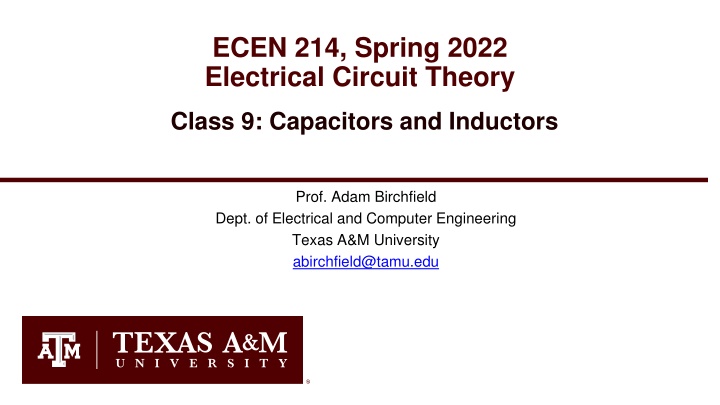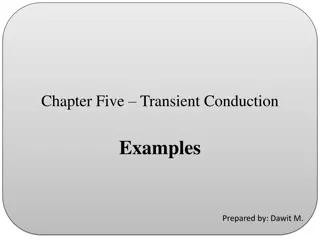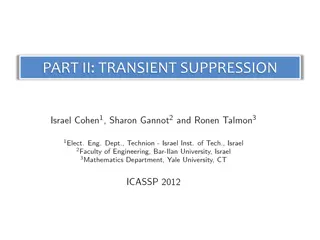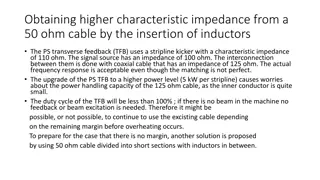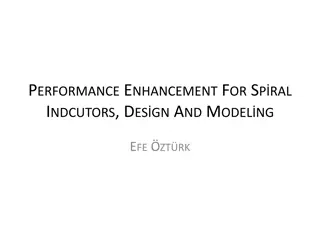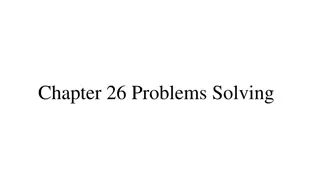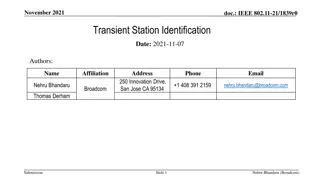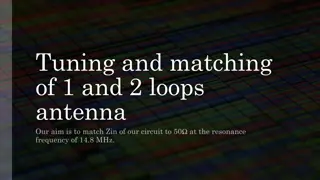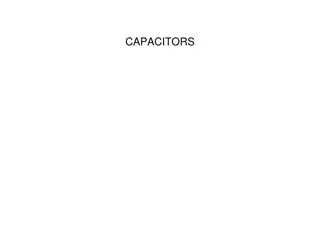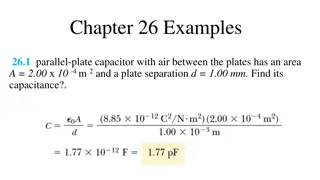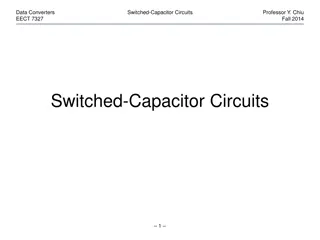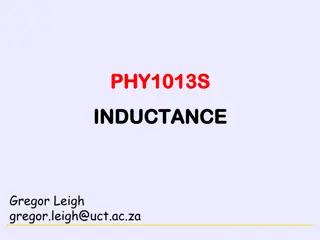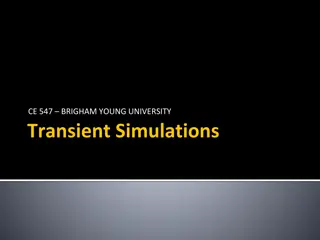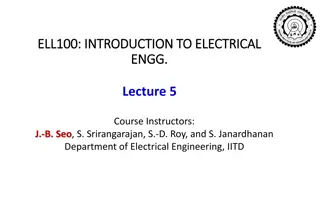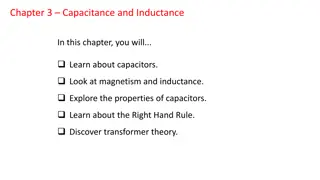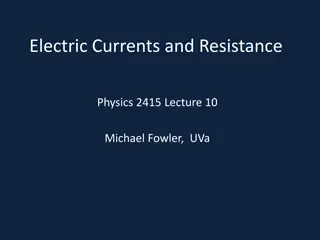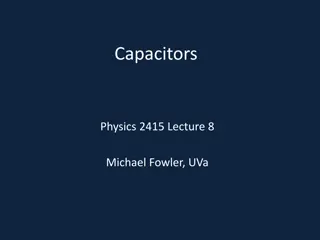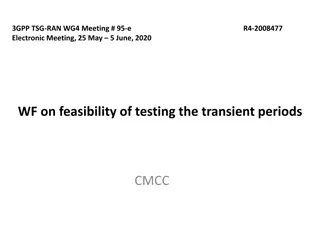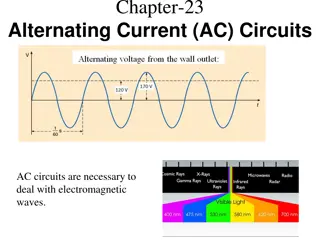Transient Circuit Analysis: Capacitors and Inductors
This content delves into the fundamental properties and behaviors of capacitors and inductors in electrical circuits. It covers how these components store and release energy, their I/V relationships, properties in steady-state conditions, instantaneous changes, and power and energy considerations. The discussion includes the equations that govern their behavior over time and transitions in circuit states before and after switches.
Download Presentation

Please find below an Image/Link to download the presentation.
The content on the website is provided AS IS for your information and personal use only. It may not be sold, licensed, or shared on other websites without obtaining consent from the author.If you encounter any issues during the download, it is possible that the publisher has removed the file from their server.
You are allowed to download the files provided on this website for personal or commercial use, subject to the condition that they are used lawfully. All files are the property of their respective owners.
The content on the website is provided AS IS for your information and personal use only. It may not be sold, licensed, or shared on other websites without obtaining consent from the author.
E N D
Presentation Transcript
ECEN 214, Spring 2022 Electrical Circuit Theory Class 9: Capacitors and Inductors Prof. Adam Birchfield Dept. of Electrical and Computer Engineering Texas A&M University abirchfield@tamu.edu
2 Transient Circuit Analysis So far, we have been solving for voltage, current, power, without regard to time. This is fine for steady-state dc or for instantaneous situations. Now, we will look at how circuits change over time. Two main elements will be considered: capacitors and inductors. Both of these have an equation that depends on time. Capacitors store energy in the form of an electric field between two charged plates (sort of like it is storing voltage ) Inductors store energy in the form of a magnetic field around a coil of wire (sort of like it is storing current ) We ll solve these (1) steady-state before the switch, (2) instantaneously after the switch, (3) steady-state after the switch Image from Ulaby, Maharbiz, Furse
3 Introduction to Inductors and Capacitors Inductors and capacitors are passive devices which store (and release) energy (energy is not created/generated by a passive device). Inductor Capacitor + V _ + V _ Circuit Symbol i i dv di i = C Fundamental I/V relationship v = L dt dt L=inductance (Henrys) C=capacitance (Farads) Units
4 Properties of Inductors and Capacitors From the fundamental I/V relationship we can infer several properties of inductors and capacitors. Inductor Capacitor Fundamental I/V relationship ? = ??? ? = ??? ?? ?? The current in an inductor cannot change instantaneously. To do so would cause an infinite voltage to appear. When a circuit with an inductor reaches steady state, the voltage across the inductor will be zero. An inductor acts like a short circuit in steady state. The voltage across a capacitor cannot change instantaneously. To do so would cause an infinite current to flow. When a circuit with a capacitor reaches steady state, the current through the capacitor will be zero. An capacitor acts like an open circuit in steady state. Instantaneous changes Steady State (when things are not changing with time)
5 Inverse to Fundamental I V Relationships From the fundamental I V relationships we can also derive inverse relationships. Inductors ? = ??? Capacitors ? = ??? ?? ?? ? ??? ???? ? ??? ???? ? ? ?? = ? ? ? ?? = ? ?? ?? ?? ?? ? ? ? ? ?? = ? ? ? ? ?? ? ? ?? = ? ? ? ? ?? ?? ?? ? ? ? ? = ? ?? +1 ? ? = ? ?? +1 ? ? ? ?? ? ? ? ?? ?? ??
6 Power and Energy in Inductors and Capacitors From the fundamental I V relationship we can infer several properties of inductors and capacitors. Inductor Capacitor Fundamental I V relationship ? = ??? ? = ??? ?? ?? ? ? = ? ? ? ? = ??(?)?? ? ? = ? ? ? ? = ??(?)?? Power ?? ?? =? ? ?? =? ? ?? ?2(?) ?2(?) 2 2 ? ? =?? ? ? =? ? ? =?? ? ? =? Energy ?? ?? 2?2(?) 2?2(?)
7 Example 1 for an RC Circuit 1. Steady-state before the switch: 10 2. Instantaneously after the switch: Switch closes at ? = 0 seconds - ? + Initial voltage on capacitor is 2 V ? ? = 5 ?? 3. In steady state after the switch: What happens to the energy that was stored in the capacitor?
8 Example 1 for an RC Circuit 1. Steady-state before the switch: ? = 2 ? ? = 0 ? Energy stored in the capacitor = ?2? = 20 ?? 10 Switch closes at ? = 0 seconds 2. Instantaneously after the switch: ? = 2 ? - ? + ? = 2? 10 = 0.2 ? = ? ? = ? ? Initial voltage on capacitor is 2 V ? Equation: ??? ? ? = 5 ?? ?? ? 3. In steady state after the switch: What happens to the energy that was stored in the capacitor? ? = 0 ? ? = 0 ? Energy stored in the capacitor = 0 J
9 Inductors in Series Inductors combine in series exactly like resistors. ?? ?? ?? ?? ?1 ?2 ?2= ?2 ?1= ?1 i ?? ?? ?1_ ?2_ + + ? = ?1+ ?2= ?1+ ?2 _ + ? ??? ?? ?? ? = ??? i ???= ?1+ ?2
10 Inductors in Parallel Inductors combine in parallel exactly like resistors. ? Using KCL: ? = ?1+ ?2 + ?1 ?2 ??1 ?? ? = ?1 ?1 ?2 ? ??2 ?? Differentiating: ?? ??=??1 ??+??2 ? = ?2 ?? _ ? ? ?1+? Substituting: ???= + ?2 ? 1 1 ?1 +1 ?? ?? ??? = ? = ??? ? ??? ?2 _
11 Capacitors in Series Capacitors in series combine like resistors in parallel. ??2 ?? ??1 ?? ? = ?2 ? = ?1 Using KVL: ? = ?1+ ?2 ?1 ?2 Differentiating: ?? ??=??1 ??+??2 i ?? ?1_ ?2_ + + ? ?1+? ? Substituting: ???= ?2 _ + ? 1 1 ?1 +1 ??? = ??? ?2 i ?? ?? ? = ???
12 Capacitors in Parallel Capacitors in parallel combine like resistors in series. ? Using KCL: ? = ?1+ ?2 + ?1 ?2 ?? ?? ?1= ?1 ?1 ?2 ? ?? ?? Substituting: ?2= ?2 ?? ??= ?1 ?? ??+?2 ?? ?? ??? _ ?? ?? = ?1+ ?2 + ? ?? ?? ??? ? = ??? ? ???=?1+ ?2 _
13 Example 2 First, combine inductors in parallel Switch closes at ? = 0 seconds ? + 6k +_ 40 mH 5 V ? 12 k 10 mH _
14 Example 2, Cont. 1. Steady-state before the switch: Switch closes at ? = 0 seconds ? + 6k 2. Instantaneously after the switch: +_ 8 mH 5 V ? 12 k _ 3. In steady state after the switch: What if the switch opens back up later?
15 Example 3 The switching action is to add an accidental short circuit between a and b. What s the instant and steady-state current through the short circuit? a 100?F 0.2 5A 30 1?F 0.5 b
16 Return to Example 1, How Can We Find v(t), i(t)?
17 What You Need to Know Today Capacitors Fundamental equation: ? = ??? ??, where C is capacitance in Farads Add in parallel, combine in series the way resistors do in parallel In steady-state, they act like an open circuit Energy stored is ??2 Inductors Fundamental equation: ? = ??? ??, where L is inductance in Henries Combine in series and parallel the same way as resistors In steady-state, they act like a short circuit Energy stored is ??2 Transient circuit solutions We are solving for ? and ? as a function of time, ? ? and ?(?) Write the differential equations using KVL and KCL Next class we will start to work on solving them
18 Assignments Quiz Wednesday Feb 23 on Op-Amps Review class notes, handout, Zybook Quiz next Monday Feb 28 on today s material Stay ahead of reading and homework assignments Homework 4 on Op-Amps is due Monday, Feb 28 Homework 5 on Inductors, Capacitors, first-order circuits is due Monday, March 7 Reading 6 is due Monday, March 7 Review in-class examples and notes Practice, practice, practice! Don t forget, you need to go to office hours once in either January or February and again in either March or April. Bring at least one technical question!
